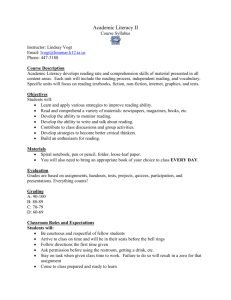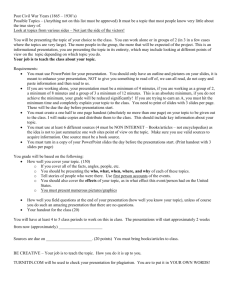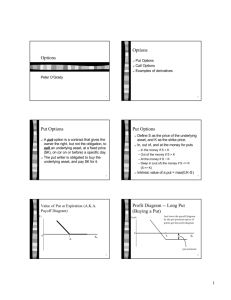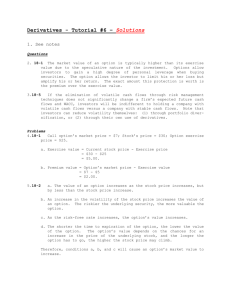Maximum loss - Interactive Brokers
advertisement
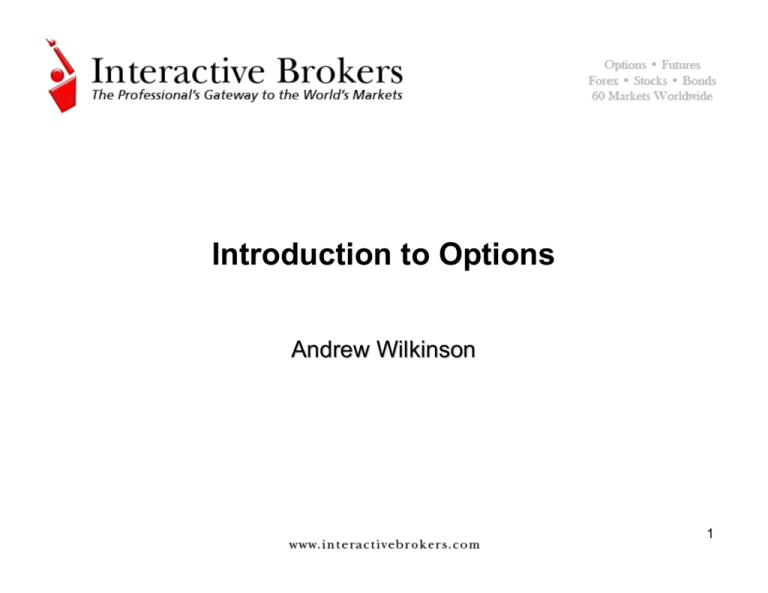
Introduction to Options Andrew Wilkinson 1 Disclosure of Risk Options involve risk and are not suitable for all investors. For more information, read the “Characteristics and Risks of Standardized Options” before investing in options. For a copy call 203 618-5800 or click here. There is no guarantee of execution. Orders will be routed to US options exchanges. Interactive Brokers LLC is a member of NYSE, NASD, SIPC In order to simplify the computations, commissions, fees, margin interest and taxes have not been included in the examples used in these materials. These costs will impact the outcome of all stock and options transactions and must be considered prior to entering into any transactions. Investors should consult their tax advisor about any potential tax consequences. Any strategies discussed, including examples using actual securities and price data, are strictly for illustrative and educational purposes only and are not to be construed as an endorsement, recommendation or solicitation to buy or sell securities. Past performance is not a guarantee of future results. Most strategies involving futures and/or options spreads require a margin account. Supporting documentation for any claims and statistical information will be provided upon request. 2 Bulls & Bears… First, understanding the descriptive graph A word on volatility and options pricing Then look at some directional trades for bullish or bearish outlooks Next, some direction-neutral trades when the trader wants prices to stagnate or explode 3 What does the graph show me? X-axis depicts price of underlying ($) Y-axis measures profit and loss Combines price variation with cost & P/L of trade Allows trader to immediately visualize: Trade cost Maximum loss Maximum profit Breakeven points 4 What does the graph show me? Buying any option costs a ‘premium’ (debit) Maximum loss can be shown visually as a horizontal line parallel to (and below) the X-axis Selling an option creates a credit 5 Points to Remember These basic strategies don’t change Skill is knowing when to apply them Each strategy needs a buyer and a seller Rule of thumb: Long strategies will show an initial cost BELOW the zero line (DEBIT) Short strategies will show an initial ‘gain’ ABOVE the zero line (CREDIT) Calculating the breakevens and P/L max-mins flows from there What IS different is the HEIGHT of the debit or credit in each market or even between equities Primary reason is VOLATILITY 6 Volatility Historic volatility measures the annualized standard deviation in price of underlying Implied volatility attempts to predict perceived price movement in the future It’s a KEY determinant of option price Share prices sit across a spectrum ranging from low risk to high risk The amount of risk determines the volatility 7 Volatility Nasdaq composite versus Dow industrials iShares Technology ETF (IYW) Historic volatility = 18.4 Implied volatility = 20.1 iShares Industrials ETF (IYJ) Historic volatility = 13.7 Implied volatility = 13.6 8 Long Call Examples Just to reiterate earlier point about risk and volatility, take two similar priced stocks from the risk spectrum to see how it impacts option pricing Next slide discusses intrinsic and extrinsic values of a call option Simply stated INTRINSIC is that portion of an option that is “in-the-money” Extrinsic value is the price of the possibility that the option will become intrinsic during its life 9 Qualcomm calls cost 30 percent more than Home Depot Qualcomm Inc. (QCOM) $39.60 Historic volatility = 30.6 Implied volatility = 32.7 April 37.5 call = 3.30 Intrinsic value = 39.60 – 37.50 = 2.10 Extrinsic = 3.30 – 2.10 = 1.20 Home Depot Inc. (HD) $38.60 Historic volatility = 13.1 Implied volatility = 21.2 April 37.5 call is 2.00 Intrinsic value = 38.60 – 37.50 = 1.10 Extrinsic = 2.00 – 1.10 = 0.90 10 Long Call Buying a call implies a bullish view Maximum loss is cost of call option Breakeven is strike price plus premium paid Beyond here the maximum profit is unlimited with chart having 45° bias The more underlying price increases the greater the profit –shares could rise infinitely 11 Long Call Example Qualcomm Shares trading at $39.60 April 40.0 call quoted at 1.80 One month to expiration Call option nearly is at-the-money Premium is totally extrinsic (40.0 - 39.60) Maximum loss is premium of 1.80 no matter where shares settle (beneath strike) Breakeven is strike price PLUS premium = 40.0+1.80 = 41.80 Above here profit increases in line with share price If by expiration shares rise to $45.20, profit is 45.20 – 41.80 = 3.40 per contract 12 Long Put Buying a put implies a bearish view Maximum loss is cost of put option Breakeven is strike price minus premium Beyond here the maximum profit is unlimited with chart having 45° bias The more underlying price declines the greater the profit – shares could fall to zero 13 Long Put Example Home Depot Shs trading at $38.60 April 40.0 put quoted at 1.90 One month to expiration Put option is in-the-money Premium has 1.40 points intrinsic value (40.0 - 38.60) Maximum loss is premium of 1.90 if shares settle above strike Breakeven is strike price MINUS premium = 40.0 -1.90 = 38.10 Beneath here profit increases in line with share price If by expiration shares fall to $34.90, profit is 38.10 – 34.90 = 3.20 per contract 14 Covered Call Buy 100 shares and sell a call option with a higher strike price If shares rise the trader is making money When share price reaches strike price the call option starts to rise penny by penny in line with the shares and offsets the share price gain If shares fall, the falling equity value is offset in part by the call premium Shares could fall to zero 15 Covered Call Example Most options contracts = 100 shares of stock Buy 100 shares of Apple at $87.95 Sell 1 April 95.0 call option at 1.40 points Shares cost $8,795 Option generates Net cost $ 140 $8,655 Breakeven is share price MINUS premium = $86.55 (in other words cost basis is reduced) Maximum profit is AT or above strike price Above the strike price the positions offset one another so profit is capped Beneath $86.55 the value declines in line with the stock price 16 Protective Put Buy 100 shares and buy a put with a slightly HIGHER strike price If shares continue to rise, the trader sees his or her equity grow – minus the cost of the put If shares fall the put will offset by each penny the loss of value of the decline below the breakeven point While shares could fall to zero, the put rises commensurately 17 Protective Put Example Most options contracts = 100 shares of stock Buy 100 shares of Oracle at $16.60 Buy 1 April 17.0 put option at 0.80 points Shares cost $1,660 Option cost $ 80 Net cost $1,740 Breakeven is share price PLUS premium = $17.40 (in other words cost basis is increased) Maximum profit is unlimited and occurs as shares increase above $17.40 The put option protects trader against share price decline below strike price minus cost or 17.0 – 0.80 = 16.20 Beneath $16.20 the put value increases in line with the stock price decline 18 Bull Call Spread Used when shares are expected to rise Buy a call with a strike above the current underlying price Trade established as a debit Sell a call with an even higher strike price with the same underlying and expiration date The net cost is the maximum loss Maximum gain is capped at the higher strike price = difference in strikes – premium paid Above higher strike the gain from the long lower strike is exactly offset by losses from the higher strike 19 Currency Futures – Bull Calls Let’s move to currency futures How does one capture the potential unwinding of the “carry-trade?” A call spread is a less risky solution but limits the upside to the trade Let’s look at how call options were priced before the recent surge in the yen Feb 14, June yen futures trading at 84.16 20 June Japanese Yen Future March 5 – June contract closed at 87.49 21 Bull Calls Example Action: Feb 14. June future closed @ 84.16 Buy 1 June 86.0 call @ 0.60 points Sell 1 June 88.00 call @ 0.30 points Long 1 June 86/88 bull call spread @ 0.30 Result: March 5. June future closed @ 87.49 Sell 1 June 86.0 call @ 2.29 points Buy 1 June 88.0 call @1.31 points Closed June 86/88 bull call spread @ 0.98 Profit is 0.98-0.30 * $12.50 = $850 22 June Bull Call - Metrics Had we had the foresight to play this trade via the underlying we’d have bought outright – long June yen future @ 84.16 The profit had we sold at 87.49 would have been 333 * $12.5 = $4.162.50 Maximum drawdown two days into the trade was 83 pips when June fell to 83.33 Loss would have been $1,037.50 By using a bull call spread our loss was pinned to just 30 points or $375 at the start Maximum profit in this case would be distance between the upper and lower strikes (88-86=200) LESS net premium or 200-30 =170 That would occur at upper strike price of 88.0 Maximum loss is our cost of $375, which occurs at any level beneath lower strike price of 86.0 23 Bear Put Spread Used when underlying is expected to fall Buy a put with a strike below the current underlying price Sell a put with an even lower strike price and the same underlying and expiration date The trade is established as a debit The net cost is the maximum loss Maximum gain is at the lower strike price = difference in strikes – premium paid Below the lower strike the gain from the long higher strike is exactly offset by losses from the lower strike 24 Bear Spread Example A trader believes the price of May crude oil might fall from current $62.04 Buy 1 May 60.0 put @ 2.08 Sell 1 May 57.0 put @ 1.08 Net cost of May 60/57 bear put spread 100 points Maximum loss is 100 points * $10= $1,000 at values of 60 and above Maximum profit is strike spread (6057=3) minus cost of spread = 3-1 or 200 points or $2,000 Occurs at values from 57 and lower Breakeven occurs at 59 (after the long put value exceeds trade cost) 25 Closing Thoughts Plan your trades Create a visual image to assist you Think – “premium profiling” Consider alternative strategies and “what-if” scenarios Questions? 26


